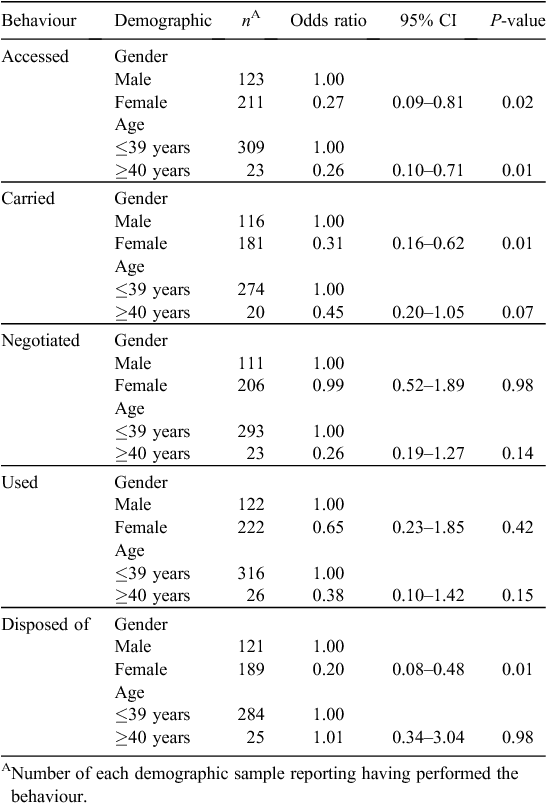Potential gender and age differences in the performance of five condom-related behaviours in the United Kingdom
Jude HancockSexual Health 11(1) 87-88 https://doi.org/10.1071/SH13185
Submitted: 23 November 2013 Accepted: 8 December 2013 Published: 4 March 2014
Abstract
Safer sex is important and comprises of a series of five condom-related behaviours: accessing, carrying, negotiating, using and disposing. This study explored potential gender and age differences in these condom-related behaviours. Data suggests gender differences exist for accessing, carrying and disposing behaviours. An age difference was seen in accessing behaviour. Therefore future safer sex interventions should acknowledge the potential gender and age differences in these condom-related behaviours.
Safer sex using condoms comprises a series of five condom-related behaviours: accessing, carrying, negotiating, using and disposing. Gender and age differences have been reported as factors influencing the performance of these behaviours. Guidelines for sexual heath improvement in the United Kingdom (UK) acknowledge that safer sex practices should be promoted across the lifespan, and recognise that a series of behaviours is required.1 To date, there appears to be no data exploring previous self-reported performance of all five condom-related behaviours from one sample population. Although guidelines support a lifespan approach to safer sex, it would be useful for public health specialists to know who tends to perform which of the five condom-related behaviours in order to design successful interventions.
As part of a cross-sectional study to design a safer sex intervention,2 between April and June 2011, 363 individuals (236 female, 127 male) aged between 14 and 74 years were asked if they had ever performed each of the five condom-related behaviours (e.g. ‘Have you ever used condoms?’). Ethical approval was obtained from Coventry University, UK. Data were collected using an online questionnaire and subjected to a series of binary logistic regressions analyses for each of the five condom-related behaviours in relation to gender and age.3 Age data were grouped according to Darker and colleagues’ categorisation:4 younger individuals aged ≤39 years (n = 330) and older individuals aged ≥40 years (n = 29). This split resulted in unequal group sizes; therefore, the data were also analysed with more even sized groups (≤25 years; n = 259 and ≥26 years; n = 100), yet the findings remained similar. The four participants that did not provide age data were excluded from the age analyses.
Results demonstrated a significant gender difference in self-reports of having accessed (P = 0.01), carried (P = 0.01) and disposed of (P = 0.01) condoms. Female participants were 73% less likely to have accessed, 69% less likely to have carried and 80% less likely to have disposed of condoms (Table 1). There were no significant gender differences in relation to reports of having ever negotiated (P = 0.98) or used condoms (P = 0.41). In terms of age differences, a significant difference between age groups in reports of having accessed (P = 0.02) condoms was present. Older individuals (i.e. those aged ≥40 years) were 74% less likely to have ever accessed condoms (Table 1). There were no significant age differences in the reports of ever having carried (P = 0.08), negotiated (P = 0.16), used (P = 0.19) or disposed of (P = 0.98) condoms.

|
Although the use of simple dichotomous measures cannot be taken as an accurate indication of current behaviour in relation to safer sex practices, the findings suggest that gender differences imply that responsibility before and after the sexual act rely on male impetus. Age differences suggest that younger individuals are more likely to access condoms in order to be able to practice safer sex. Future safer sex interventions should consider that gender and age differences do exist in the previous performance of the five condom-related behaviours. There is clearly a need to encourage the performance of all condom-related behaviours in both genders and all age groups to ensure that individuals are prepared for safer sexual contact.
Conflicts of interest
None declared.
References
[1] Department of Health. A framework for sexual health improvement in England. London: The Department of Health: 2013. Available at https://www.gov.uk/government/publications/a-framework-for-sexual-health-improvement-in-england [verified 20 December 2013][2] Hancock J. Exploration of five condom-related behaviours in the UK: development and evaluation of a theory-based online safer sex intervention. Unpublished PhD thesis, Coventry University, UK. 2013.
[3] Newby K, Wallace LM, Dunn O, Brown KE. A survey of English teenagers’ sexual experience and preferences of school-based sex education. Sex Educ 2012; 12 231–51.
| A survey of English teenagers’ sexual experience and preferences of school-based sex education.Crossref | GoogleScholarGoogle Scholar |
[4] Darker CD, French DP, Longdon S, Morris K, Eves FF. Are beliefs elicited biased by question order? A theory of planned behaviour belief elicitation study about walking in the UK general population. Br J Health Psychol 2007; 12 93–110.
| Are beliefs elicited biased by question order? A theory of planned behaviour belief elicitation study about walking in the UK general population.Crossref | GoogleScholarGoogle Scholar | 17288668PubMed |


